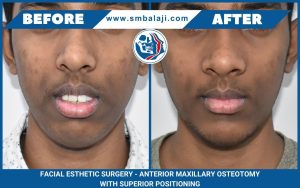Patient with hemifacial microsomia presents for treatment
Hemifacial microsomia is a congenital disorder. It affects the development of usually one side and rarely both sides of the face. One child in every 5600 children born worldwide is afflicted by hemifacial microsomia. This condition results from the abnormal development of the first and second pharyngeal arches. Ears, mouth, and lower jaw bone are most often affected. The patient here is a young girl with hemifacial microsomia. She has left microtia and absence of the left mandibular condyle. Her parents researched the Internet for the best facial reconstruction surgeon. They zeroed in on our hospital based upon the Internet search results.
Growth centre transplant planned for replacing missing condyle
Dr SM Balaji examined the patient and ordered 3D axial CT scans. This revealed the presence of a rudimentary left condyle. He planned reconstruction of the condyle and ramus with costochondral rib grafting. This procedure is also known as growth centre transplantation. Parents of the patient were in full agreement with the treatment plan.
Costochondral rib graft with perichondrium obtained
Under general anesthesia, a costochondral rib graft with perichondrium was first obtained. The incision was then closed after ensuring absence of thoracic perforation. Subcuticular sutures closed the incision for minimal post healing scar.
Surgical reconstruction of missing left condyle
Following this, markings were then made over the mastoid region. This was to map out the distorted anatomy of the underlying structures. An incision was first made followed by dissection down to the condylar region. Facial nerve and parotid duct were duly protected throughout the surgery. The rudimentary condyle was present below the ear tag. The pterygomandibular raphae was then stripped off. The costochondral graft was then positioned in the posterior ramus. Upper part of the growth centre transplant was then positioned in the glenoid fossa. This was then fixed with screws. The incision was then closed in layers using subcuticular sutures.
The patient recovered well from general anesthesia. The patient presented later at our hospital and expressed complete satisfaction.





